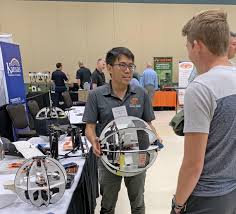
Oklahoma State scientists were front and center at a recent conference that focused on drones and was held in Salina, Kansas.
Congressmen, aerospace engineers, firefighters, farmers and pilots, among others, converged on Tony’s Pizza Events Center on Aug. 21-22 for the Unmanned Aircraft Systems (UAS) Tech Forum
The annual event is produced by the UAS Cluster Initiative and the U.S. Small Business Administration (SBA) and sponsored by many local organizations. Thursday was filled with sessions divided by different tracks: agriculture, first responder and innovation. The sessions were on different topics within the tracks, and they included themes presented by experts in the field. There was also a large group of vendors at the event, which included exciting demonstrations of new and emerging technology.
Drones in agriculture
Agriculture tends to be on the forefront of technology, with early adoption by farmers and researchers.
Many tractors and combines are already being guided by satellite, and sprayers can be set to variable rates of application in order to use best practices. Unmanned aircraft can be used to even further improve yields and conservation. Gregory Crustsinger, drone ecologist at Scholar Farms, said “there is a lot of hype around drones in agriculture,” and all of the panelists agreed that it is possible to collect too much data if a farmer or agronomist isn’t sure what to do with it.
Owen C. Unangst, director of Technology Sector and Cherokee Nation Technology, said that drones can be used to better understand the variables in farming, monitor plants and animals, manage data and analyze yields. Matt Isenbarger, manager of AeroVironment, conceded that drones are “a long way away from replacing agronomists,” and that a “boots-on-the-ground” approach, combined with new technology, is really the best way to utilize the tools at hand. Mapping by drones, combined with software, is an excellent addition to farming and ranching, as well.
Helping the helpers
The Kansas Department of Wildlife, Parks and Tourism has six drones with five operators available to assist different agencies across the state, including law enforcement and search and rescue.
Eric Dneault, captain of KDWPT, said “we’re still so new [to UAS] that we don’t know all of the uses yet,” but they have used their drones for activities like documenting damage and assisting with locating drowning victims. Search and rescue teams have found that data and images collected from UAS help in obtaining assistance through FEMA for disaster victims.
The public information component is often overlooked, said Christopher Todd, executive director of Air International Response Team.
“The public wants to know ‘how bad is bad’, and the drones can help us give them an answer,” he said.
Drones are much more affordable to police and fire agencies, so many more of them are utilizing the UAS over the much more expensive, and sometimes unavailable, alternative of airplanes or helicopters. Crutsinger was called upon by the U.S. Forest Service during the 2018 Camp Fire in California. He assembled a team to collect video and images, as well as create maps of the area. His team took 500 flights in just two days, and they created side-by-side images of before and after the fire for residents in the area.
Residents were able to Google their addresses and locate what their properties looked like after the fire, which may have been very difficult to do without the assistance of the technology, since the area looked much different after the fire. Another major help to first responders is a live feed of an incident. At the moment, most action is relayed to Incident Command (IC) by radio, which only allows one person to talk at a time. However, a drone with a live feed can cut down on radio traffic and give IC a much better idea of what is happening on scene.
What is coming?
Benjamin Linder, AARS group leader at George Butler Associates said, “every single week, we develop a new use for remote data sensing.”
The possibilities are virtually endless, but Linder warned that not every job can be done with drones. Some jobs, such as internal bridge inspections, still need a human touch to be most effective.
However, drones can be used to do a variety of jobs, from X-raying power lines to capturing wild dolphin snot. The Kansas Department of Transportation recently surveyed Kansans to get an idea of their feelings on drones. Sixty percent of the respondents had a positive feeling about drones, and 11% reacted negatively to them. The largest concern among Kansans about drones was an invasion of privacy.
KDOT has been conducting testing with UAS, and they have been careful to hold town hall meetings to inform residents on their activities. KDOT wants Kansans to know that UAS is just another form of aviation — one of Kansas’ main economic products. “We are Kansas; we are aviation,” is a new slogan KDOT is promoting to help people better understand UAS. One thing is for sure: UAS is a rapidly expanding field. More and more agencies are using them in a wide variety of ways. The correct and effective use of UAS can help people to do things they never could do before in safer, faster and more accurate ways.





